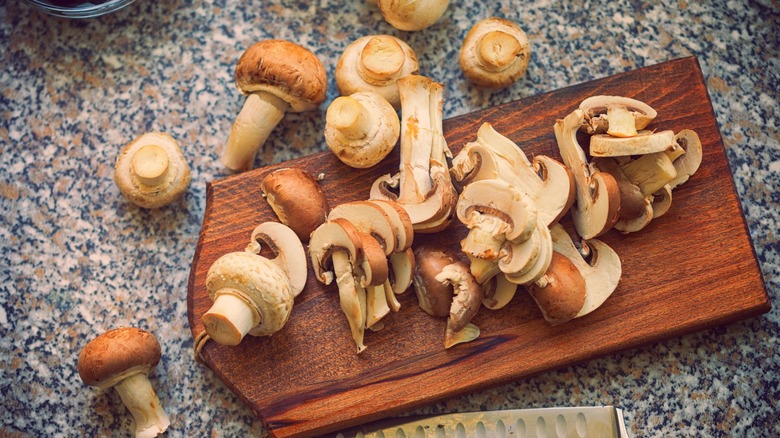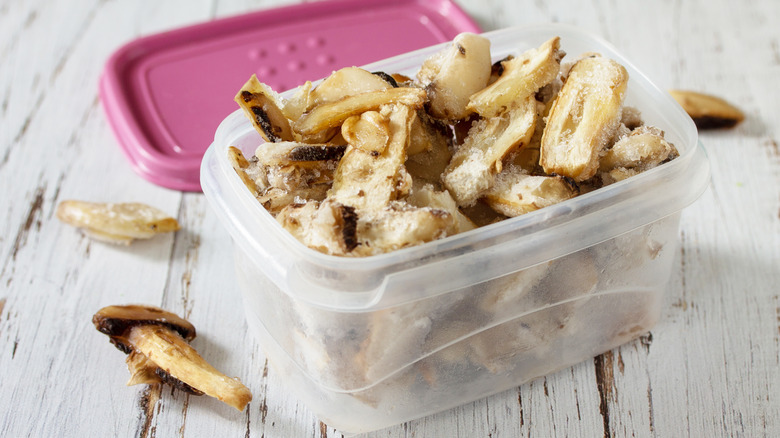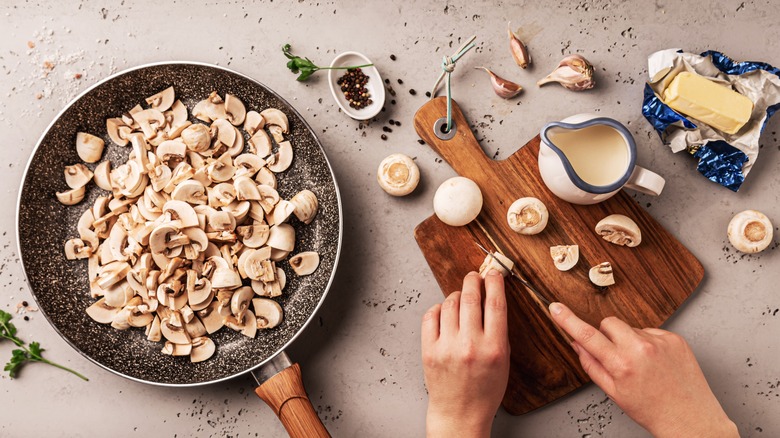How To Store Mushrooms In The Refrigerator, Sliced Or Whole
Like many other fruits and veggies, most types of mushrooms are highly sensitive to their environment, bruising at the slightest touch or growing slimy if the air is too humid. Fortunately, you can extend mushrooms' shelf life by taking the proper measures when refrigerating them, whether you bought them whole or sliced.
If your fungi are left whole, you want to keep them dry, so avoid cleaning mushrooms until right before using them. You should also store them with paper towels underneath and/or in a paper bag to soak up excess moisture, while still allowing airflow. If the towels or bag become visibly wet, swap them out for fresh, dry wrappings. Above all, avoid storing mushrooms in plastic, as this material will lock in moisture and quickly result in spoiled fungi. Stored properly, whole mushrooms can last up to a week in the fridge.
As for sliced mushrooms, many of the guidelines remain the same. Hold off on washing them for as long as possible, and wrap them with an absorptive material. Unlike whole mushrooms, however, you can store sliced mushrooms in an airtight container. In the best case scenario, sliced mushrooms will last up to five days with proper treatment, but they're much more prone to spoilage than whole ones. Try to use them quickly, or better yet, only slice up as many mushrooms as you need at a time, storing the rest of them whole.
Can you store mushrooms in the freezer?
Because mushrooms have a relatively short shelf-life even in the fridge, you might wonder if you can store them in the freezer. You can indeed freeze mushrooms for later use, but there are a few things you'll want to keep in mind. Firstly, you should freeze mushrooms while they're still fresh, rather than waiting until they're about to go bad. When defrosted, mushrooms past their prime will be slimy and none too appetizing.
To help preserve their texture, you should also give the mushrooms a quick cooking job, whether that's sautéing or steaming. This can prevent a rubbery texture after thawing. After cooking the mushrooms to about 90% doneness, place them in an airtight bag for freezing. You should ideally lay your bags of frozen food flat to both maximize your freezer space and accelerate the thawing process, when the time comes to use the mushrooms. If all goes well, your fungi should last up to a year in the freezer.
Thaw frozen mushrooms in the fridge, or at room temperature if you know you'll be using them straight away. Like most defrosted produce, your mushrooms will be soggier than they were before freezing, but you can still use them in casseroles, fried rice, or even a porcini mushroom and herb soup recipe. Any dish where they'll be chopped finely or blended is a good way to conceal their altered texture.
What to do with mushrooms past their prime
Mushrooms are one of those veggies that clearly announce when they're going bad. The first sign of impending spoilage is the appearance of dark spots, but the mushrooms are still safe to eat at this point. However, as more time passes, they will become more discolored, soft, shriveled, and even sticky or slimy to the touch. Spoiled mushrooms will also take on a rotten and rank smell, as opposed to a pleasantly earthy scent. Toss any fungi that display these traits.
Going back to mushrooms that are just slightly past their prime, there are plenty of tasty ways to use them up and avoid food waste. Just like with thawed mushrooms, you'll want to use them in recipes where a small change in color or texture will go unnoticed, such as in a soup, sauce, chili, or savory mushroom stew recipe. Avoid using less-than-fresh fungi in recipes where they're meant to be the star ingredient. If you're set on making a mushroom salad or side dish, just follow proper storage practices for fresh ones, and you shouldn't be surprised by any untimely spoilage.



